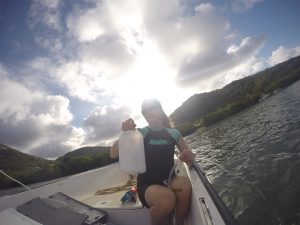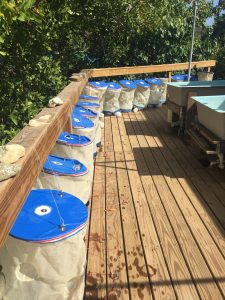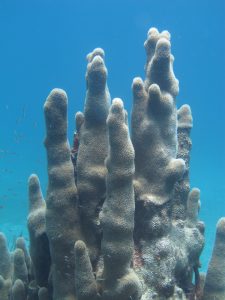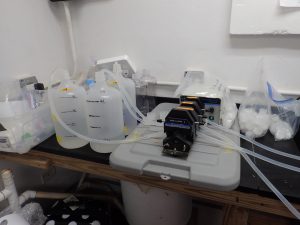A day in the life in St. John, USVI: Harvesting larval reef fish and coral reef seawater microbes
Written By: Laura Weber

Laura sampling seawater! She’s using a groundwater pump to sample water from ‘reef depth’ – the water that surrounds and interacts with corals, sponges, algae, and other organisms that live on the reef. She is holding a large bottle to collect the seawater and the tubing that is connected to the groundwater pump in her other hand. You can even see the ‘reef depth’ water coming out of the tube! Photo: Justin Suca
About the author: Laura Weber is a PhD candidate in Biological Oceanography in the Massachusetts Institute of Technology – Woods Hole Oceanographic Institution (MIT-WHOI) Joint program. She is a member of the Apprill lab at WHOI and studies microbial (bacteria and archaea) interactions in coral reef ecosystems to get a better handle on how these interactions impact coral reef ecosystem functioning.
Participating in scientific fieldwork is one of my favorite things about being a Ph.D. student and a scientist. The days are long, the obstacles frequent, and the amenities few (depending on where you are), but I wouldn’t trade my field experiences for anything else. I have met and worked with some truly excellent scientists and people in the field. They have taught me about their science, how to deal with seemingly insurmountable challenges (cough *sinking boat * cough), how to be a team player, and how to be a good scientist and an even better person (this is cheesy, but I’m honestly a cheesy person). Not all fieldwork experiences are this way, but I have been fortunate enough that mine have been.
You see, fieldwork is similar to summer camp. In fact, fieldwork at the Virgin Islands Environmental Resource Station (VIERS) in St. John, U.S.V.I. is definitely on par with summer camp. We sleep in little cabins that are nestled in a valley by the ocean, the access road to camp is essentially a series of potholes and small ponds (*only jeeps and trucks welcome *), we cook meals together in a tiny kitchen equipped only a stove-top, and we shower outside with lukewarm water. The mosquitoes and no-see-ums are fierce, but the night sky inside the Virgin Islands National Park is truly magnificent. The temperature inside of the lab at VIERS is sweltering, but the beauty and slight coolness of Great Lameshur Bay that lies right next to it offers a chance of escape. When you work here, you will spend at least half of your day (if not more) out on the water or underwater and this is where the real magic of fieldwork lives.
I have been able to experience this wonderful and wild place because I am a member of a large and dynamic research team that is studying several coral reefs located on the southern side of the island of St. John. The project is lead by WHOI scientists Dr. Amy Apprill (my Ph.D. advisor), Dr. Aran Mooney, and Dr. Joel Llopiz. Amy is a coral reef microbial ecologist, Aran studies sound production on reefs (reef acoustics), and Joel specializes in reef fish and how their larvae recruit to the reefs. Amy, Aran, and Joel have also recruited a team of people, the other members of the ‘Coral Chorus’ group, to help with the project including WHOI post-docs, other Ph.D. students and graduate students, exceptional undergraduate students, lab technicians, and amazing WHOI retirees. Having such a diverse (including differences in age, discipline, experience, and culture) and large team enables us to study these reefs using an interdisciplinary approach, hopefully allowing us to understand the many variables (microbes, benthic cover, sound, currents) that may impact reef fish recruitment.

A panoramic view of Great Lameshur Bay from the VIERS dock. Photo: Laura Weber
My role in this project is to assist with sampling the microbial communities that live in the reef seawater at our different sites, to perform reef surveys that help us understand the diversity and coverage of stony corals, and to collect samples for my Ph.D. dissertation (stay tuned – I’ll talk about this in a future BIG blog post!). I also assist others as needed and past jobs have included (but are not limited to): calibrating instruments, inserting batteries into flashlights, lifting and hauling scuba cylinders, sorting reef fish larvae, assembling battery packs, updating boat logs, deploying light trap nets, swimming into giant mesh traps, and hammering rebar into sand while scuba diving.
I decided to write this blog post so that I could give you an idea about my fieldwork life at VIERS in St. John! So here we go!
July 23, 2017
4 am: My alarm rings and I wake up. I make a pot of coffee and scrounge in the kitchen in the dark for yogurt and cereal so I don’t wake anybody else up. I eat breakfast outside in the few square feet where I get cellular service and check my email inbox on my phone. Meanwhile, three other members of our team wake up and have breakfast.
4:45 am: We leave camp and walk down to the lab.
5 am: We fill up the boat with gas and then load the boat with materials needed to collect, sort, and store larval reef fish (also known as light trap retrieval equipment), seawater sampling equipment (many 4 liter bottles, glass vials, smaller plastic bottles, and an electronic instrument that measures conductivity (salinity), depth, and temperature [CTD]), and ourselves. We depart from the VIERS lab dock and drive out into the middle of Great Lameshur Bay just as the sun begins to rise.

All of our light traps rinsed, assembled, and ready to be re-deployed! Photo: Laura Weber
5 am – 9 am: We visit our 11 (or 12 or 13?) sites via boat to retrieve our light trap nets. Light traps are big nets that we deploy at each of our sites at dusk the previous day to collect larval reef fish and zooplankton (teeny animals that float around in the ocean). While we are on the boat and retrieving the light traps, we wash the larvae and zooplankton out of each net and into a jar (called the ‘cod-end’), drain the fishy mixture collected in the jar through a sieve to concentrate all the specimens, and then preserve the specimen patty in ethanol. These samples will then be sorted and the abundance and diversity of larval reef fish will be recorded for each of our sites. Deploying and retrieving light traps happens everyday or every other day according to the moon phases – reef fish recruitment to reefs is synchronized to the moon cycle!
At a subset of our sites, Cynthia –a guest student within my lab- and I also collect surface seawater samples using our different bottles and vials and perform a cast of the CTD. The samples will be processed and preserved later when we get back to the lab. The CTD cast will give us information about the environmental conditions in the seawater where our samples were collected and this is important information for us to have during analysis of the samples.
9 am – 10:30 am: When we arrive back to the dock, we unload all of the fishy light trap nets from the boat, and then Cynthia and I begin to process our seawater samples. We pass most of the seawater that we collected through filters, and this allows us to concentrate all of the microbial cells (>0.22 micrometers) in those samples onto the filter surfaces. We will extract DNA from these filters later and sequence that DNA (with many steps in between) to understand how tides impact microbial community composition and diversity at these sites.
10:30 am: The whole team eats second breakfast (hobbits anyone?) or early lunch and we enjoy delicious and satisfying peanut butter and jelly sandwiches (there really is nothing as delicious as a PB+J field sandwich).
11 am: We begin preparations for conducting benthic surveys at two of our reefs. I help load scuba cylinders, a dive flag, and the oxygen kit onto the boat and then I assemble all my scuba diving gear.
11:30 am – 1 pm: We leave the dock (6 on board!), complete the two benthic surveys (an hour underwater at each site), and arrive back at 1 pm just in time to go out again for another round of seawater sample collections!

A reefscape from Yawzi Point, St. John, USVI. Photo: Amy Apprill
1:10 pm – 2:20 pm: We leave the dock again, collect surface seawater samples at the same sites where we collected them earlier this morning, and return to the lab.
2:30 pm– 6 pm: I finish processing this round of seawater samples, while the rest of the team goes back out to deal with setting-up another experiment, deploying light traps, and collecting more seawater samples for the next sampling time point. While I wait for our team to get back, I meet and chat with a few scientists from California State University (CSUN) who just arrived at VIERS.

A beautiful Dendrogyra cylindricus colony at Yawzi Point, St. John, USVI. Photo: Amy Apprill
6:30 pm – 7:30 pm: The rest of the team returns with all samples collected and experiment goals accomplished –hoorah! Jess, an undergrad student, graciously cooks dinner for us back at the cabin and then delivers it to the dock so we can all eat a nice, Chipotle-inspired meal together before we have to process and collect even more seawater samples!
7:30 pm – 8:20 pm: Cynthia, Amy, and I finish filtering and preserving the seawater samples from the 6 pm time-point and then we prepare to collect and process the last round of tidal samples for the night.
9 pm – 9:15 pm: Cynthia and I douse ourselves with bug spray and then head into the mangrove forest to collect mangrove water samples. The mosquitoes are ruthless.
9:15 pm – 12:00 am: Cynthia, Amy, Justin (another MIT-WHOI PhD student/boat driver/diver/fish ecologist) and I set out for our last round of seawater sample collection and processing. We all enjoy the peaceful boat ride at night –it almost feels like you are soaring over nothing as the boat drives through the surf.
12:30 am: We walk back to camp while enjoying the beautiful night sky and then we collapse into our beds. I am only awake long enough to hear a few minutes of the Coqui tree frogs’ sweet lullaby before sleep overcomes me!

Our filtering set-up: a peristaltic pump is used to pump seawater through 0.22 micrometer filters. Photo: Laura Weber
And there you have it: just one “Day in the life” of a WHOI-MIT Joint Program PhD student! I hope you enjoyed and thank you for reading!
If you have questions, feel free to contact Laura at lweber [at] whoi [dot] edu